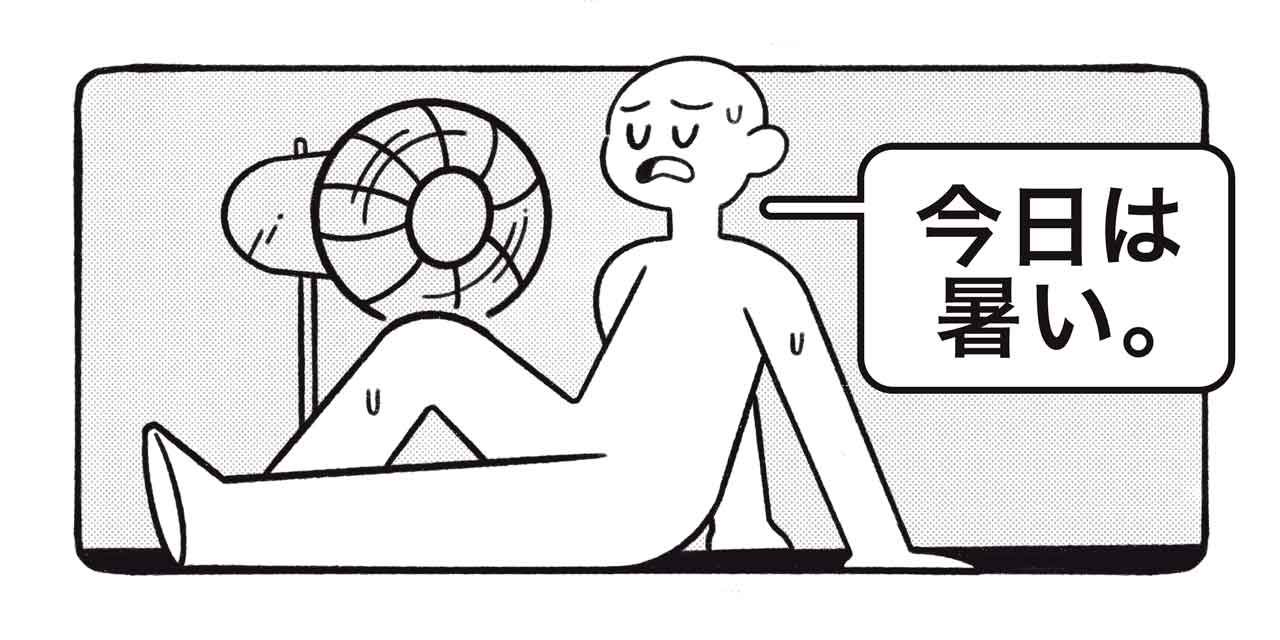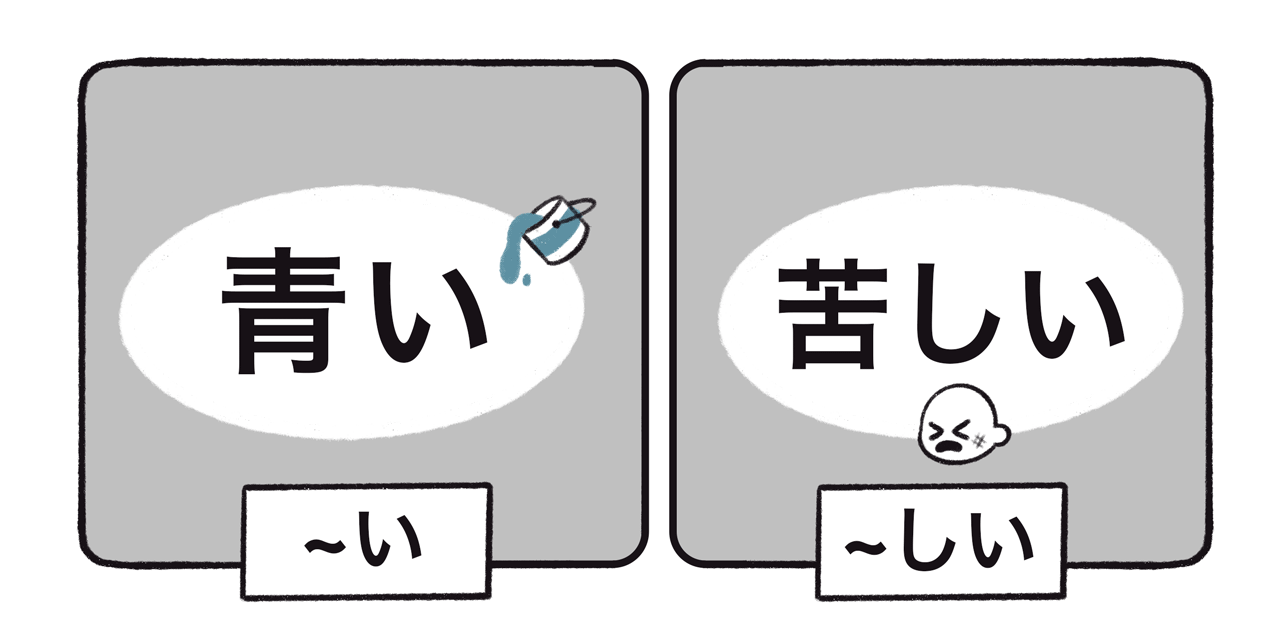Table of Contents
The Basics
The primary function of い-adjectives is to describe nouns. For example, a big cat is 大きい猫, a beautiful painting is 美しい絵, and an interesting book is 面白い本. The 〜い ending that gives this type of adjective its name is just one of many possible endings. Each ending expresses a different kind of information, such as tense—present or past—and truth value—positive or negative. This is the major way in which they differ from な-adjectives, which rely on an additional word (だ or です) to show tense and truth information.

い-Adjective Stem Form
The first step to fully understanding い-adjectives is to be able to find the stem form. The stem form of an い-adjective is the part of the word that always stays the same, no matter what ending the adjective takes. It’s usually quite simple to find. You just remove the ending and what is left is the stem. Let’s take a look, using the い-adjective, 安い (cheap):
安い → 安
い→ 安
安かった → 安かった→ 安
安くない → 安くない→ 安
A Few Tricky Stem Forms
良い
The oh-so-useful adjective いい (good) can be a little troublesome for learners. Its kanji form 良い can be read as either いい or よい without any difference in meaning (though よい sounds more formal).
The confusion arises when we remove the 〜い ending from 良い to find its stem form. Since 良 can be read as both い and よ, what is the stem? With every other ending besides 〜い, 良 is always read as よ in standard Japanese.
良い = いい or よい
良かった = only よかった
良くない = only よくない
So, the stem form of いい is よ.
This applies to い-adjectives that include いい, such as かっこいい (cool), which comprises 格好 (appearance) and いい (good). When かっこいい conjugates, don’t forget to use よ as the stem of いい. For example, the past tense form is かっこよかった.
かわいい
Unlike かっこいい, かわいい does not include いい, despite having two い characters on the end. The kanji form of this word is 可愛い, with only one い on the end. The first い is part of the reading of the kanji 愛 (わい). So it conjugates like any other い-adjective.
❌ かわよかった
⭕ かわいかった
Making this mistake is かわいくない, so don’t do it! 😉
Now that you know all about the stem form, let’s explore the three main い-adjective endings, 〜い, 〜かった, and 〜くない. There are others to learn as well, but these three are the most important to get a handle on first.
Present Tense 〜い

To show the present tense, い-adjectives end in 〜い. This indicates that we are talking about a time in the present or the future, since Japanese doesn't have a future tense. For example:
- 今日は暑い。
- Today is hot.
- 明日は暑い。
- Tomorrow will be hot.
Negative 〜くない
To show that something is negative, the ending 〜くない replaces 〜い. For example, 面白い (funny) becomes 面白くない (not-funny):
- その芸人は全然面白くない。
- That comedian isn’t funny at all.
- 面白くない芸人にはなりたくない。
- I don’t want to become a not-funny comedian.
Past Tense 〜かった
To show the past tense, い-adjectives end in 〜かった. For example, 寒い (cold) becomes 寒かった (was cold):
- 昨日は寒かった。
- Yesterday was cold.
The Position of い-Adjectives in a Sentence
い-adjectives can be used in two different positions to describe a noun. You'll find it either at the very end of a sentence, or directly before a noun.
At the End of a Sentence
When used at the end of a sentence, い-adjectives describe the subject of the sentence.
- お母さんの料理はおいしい。
- My mother’s cooking is delicious.
In this sentence, the い-adjective おいしい (delicious) comes at the end of the sentence, and it is describing the noun phrase お母さんの料理 (mother’s cooking).
It’s very common in Japanese for the subject to be left out of the sentence if it’s clear from context. In this case, the い-adjective still describes the subject, you just have to figure out what that subject is.
- おいしい!
- (This) is delicious!
Perhaps you’ve just taken the first bite of your mother’s cooking, and you say this to let her know how much you like it. There’s no need to say what is delicious, because it is clear from the situation. While English requires a dummy subject like "this" or "it" in similar situations, Japanese does not require a subject for a sentence to be grammatical.
Before a Noun

Unlike な-adjectives, which require a particle to attach to a noun, い-adjectives can appear directly before a noun without a particle between them. For example:
- 古い車
- old car
These words joined together can be used anywhere that a noun can be used, such as the subject or object of a sentence:
As the Subject
- 古い車が安いですよ。
- Old cars are cheap.
As the Object
- お父さんは古い車に乗っています。
- My father drives an old car.
Beyond the Basics
Fun (and Useful) Facts about い-Adjectives
い-adjectives were the very first type of adjective to appear in Japan, and are almost always wago, or native Japanese, rather than of Chinese or other origin. This is why い-adjectives tend to cover the most fundamental, "primal" concepts, such as basic colors and emotions, temperature, flavor, size, and so on. More complex or modern concepts are generally the realm of な-adjectives, which were imported from China much later.
As with most native Japanese words, い-adjectives are a closed class, which means that it's very rare for new ones to appear. New words do sometimes appear, though. These are often made by abbreviating existing い-adjectives to give new forms, while keeping the meaning of the original adjective. Some examples of this phenomena include キモい from 気持ち悪い (gross), ムズい from 難しい (difficult) and ハズい from 恥ずかしい (embarrassing).
Very occasionally, new い-adjectives can also be formed from loan words, such as エモい, from the English word "emotion." Mostly used by young Japanese people, エモい can be used for anything that makes you feel moved.
Whether they are shortened versions of existing い-adjectives or brand new ones derived from loan words, these new い-adjectives are almost always considered colloquial or even slang.
The Difference Between い-adjectives Ending in 〜い and 〜しい

い-adjectives can be divided into two broad types: those ending in 〜い and those ending in 〜しい. い-adjectives with 〜い endingsーlike 暑い (hot), 高い (high/expensive), and 青い (blue)ーgenerally describe physical characteristics like temperature, size, and color.
い-adjectives with 〜しい endings, on the other hand, tend to be used for more personal, emotive or "internal" characteristics, such as 楽しい (fun), 苦しい (painful) and 悲しい (sad).
Some 〜しい adjectives, like 美しい (beautiful), do describe more external characteristics, but their original meaning is generally a personal emotion. In the case of 美しい, it originally described the tender emotion we feel towards someone or something cute, and the word later developed into its modern meaning of "beautiful."
〜しい adjectives and Corresponding Verbs
Because 〜しい adjectives are personal and subjective, they are generally only appropriate for describing our own feelings. So we can say 楽しい when we're having fun, but not when we think someone else is having fun.
- 形容詞の勉強、楽しい!
- Studying い-adjectives is fun (for me)!
Many 〜しい adjectives have corresponding verbs, to allow us to talk about how other people appear to be feeling. Some examples of these verbs include 楽しむ (to have fun), 苦しむ (to suffer) and 悲しむ (to be sad).So if Mami looks like she's having a ball studying い-adjectives, you'd want to use 楽しむ rather than 楽しい:
- マミさん形容詞の勉強めっちゃ楽しんでるね!
- Mami's having a great time studying い-adjectives, isn't she!
Because the adjective itself describes our own emotions, we can't use the adjective in its original form to describe Mami's emotions. If we do this, as in the following example, it gives the meaning that it's the speaker who enjoys studying, rather than Mami:
- マミさん、形容詞の勉強めっちゃ楽しいね!
- Mami, studying い-adjectives is great fun, isn't it!
It's worth noting that there are other ways to change い-adjectives so that we can use them for other people. The two main ways are 〜そう and 〜がる.